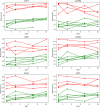Novel Outcome Biomarkers Identified With Targeted Proteomic Analyses of Plasma From Critically Ill Coronavirus Disease 2019 Patients
- PMID: 32904064
- PMCID: PMC7449255
- DOI: 10.1097/CCE.0000000000000189
Novel Outcome Biomarkers Identified With Targeted Proteomic Analyses of Plasma From Critically Ill Coronavirus Disease 2019 Patients
Abstract
Objectives: Coronavirus disease 2019 patients admitted to the ICU have high mortality. The host response to coronavirus disease 2019 has only been partially elucidated, and prognostic biomarkers have not been identified. We performed targeted proteomics on critically ill coronavirus disease 2019 patients to better understand their pathophysiologic mediators and to identify potential outcome markers.
Design: Blood was collected at predetermined ICU days for proximity extension assays to determine the plasma concentrations of 1,161 proteins.
Setting: Tertiary care ICU and academic laboratory.
Subjects: All patients admitted to the ICU suspected of being infected with severe acute respiratory syndrome coronavirus 2, using standardized hospital screening methodologies, had blood samples collected until either testing was confirmed negative on ICU day 3 (coronavirus disease 2019 negative) or until ICU day 10 if the patient positive (coronavirus disease 2019 positive).
Interventions: None.
Measurements and main results: Age- and sex-matched healthy control subjects and ICU patients who were either coronavirus disease 2019 positive or coronavirus disease 2019 negative were enrolled. Cohorts were well-balanced with the exception that coronavirus disease 2019 positive patients suffered bilateral pneumonia more frequently than coronavirus disease 2019 negative patients. Mortality rate for coronavirus disease 2019 positive ICU patients was 40%. Feature selection identified the top performing proteins for identifying coronavirus disease 2019 positive ICU patients from both healthy control subjects and coronavirus disease 2019 negative ICU patients (classification accuracies 100%). The coronavirus disease 2019 proteome was dominated by interleukins and chemokines, as well as several membrane receptors linked to lymphocyte-associated microparticles and/or cell debris. Mortality was predicted for coronavirus disease 2019 positive patients based on plasma proteome profiling on both ICU day 1 (accuracy 92%) and ICU day 3 (accuracy 83%). Promising prognostic proteins were then narrowed down to six, each of which provided excellent classification performance for mortality when measured on ICU day 1 CMRF-35-like molecule, interleukin receptor-12 subunit B1, cluster of differentiation 83 [CD83], family with sequence similarity 3, insulin-like growth factor 1 receptor and opticin; area-under-the-curve =1.0; p = 0.007).
Conclusions: Targeted proteomics with feature classification easily distinguished both healthy control subjects and coronavirus disease 2019 tested negative ICU patients from coronavirus disease 2019 tested positive ICU patients. Multiple proteins were identified that accurately predicted coronavirus disease 2019 tested positive patient mortality.
Keywords: biomarkers; coronavirus disease 2019; host response; inflammation; intensive care unit.
Copyright © 2020 The Authors. Published by Wolters Kluwer Health, Inc. on behalf of the Society of Critical Care Medicine.
Figures




Similar articles
-
Endothelial Injury and Glycocalyx Degradation in Critically Ill Coronavirus Disease 2019 Patients: Implications for Microvascular Platelet Aggregation.Crit Care Explor. 2020 Aug 24;2(9):e0194. doi: 10.1097/CCE.0000000000000194. eCollection 2020 Sep. Crit Care Explor. 2020. PMID: 32904031 Free PMC article.
-
Metabolomics Profiling of Critically Ill Coronavirus Disease 2019 Patients: Identification of Diagnostic and Prognostic Biomarkers.Crit Care Explor. 2020 Oct 21;2(10):e0272. doi: 10.1097/CCE.0000000000000272. eCollection 2020 Oct. Crit Care Explor. 2020. PMID: 33134953 Free PMC article.
-
Inflammation Profiling of Critically Ill Coronavirus Disease 2019 Patients.Crit Care Explor. 2020 Jun 22;2(6):e0144. doi: 10.1097/CCE.0000000000000144. eCollection 2020 Jun. Crit Care Explor. 2020. PMID: 32696007 Free PMC article.
-
Detection and Profiling of Human Coronavirus Immunoglobulins in Critically Ill Coronavirus Disease 2019 Patients.Crit Care Explor. 2021 Mar 12;3(3):e0369. doi: 10.1097/CCE.0000000000000369. eCollection 2021 Mar. Crit Care Explor. 2021. PMID: 33786445 Free PMC article.
-
Novel severe traumatic brain injury blood outcome biomarkers identified with proximity extension assay.Clin Chem Lab Med. 2021 Jun 21;59(10):1662-1669. doi: 10.1515/cclm-2021-0103. Print 2021 Sep 27. Clin Chem Lab Med. 2021. PMID: 34144643
Cited by
-
COVID-19 plasma proteome reveals novel temporal and cell-specific signatures for disease severity and high-precision disease management.J Cell Mol Med. 2023 Jan;27(1):141-157. doi: 10.1111/jcmm.17622. Epub 2022 Dec 19. J Cell Mol Med. 2023. PMID: 36537107 Free PMC article.
-
HYGIEIA: HYpothesizing the Genesis of Infectious Diseases and Epidemics through an Integrated Systems Biology Approach.Viruses. 2022 Jun 23;14(7):1373. doi: 10.3390/v14071373. Viruses. 2022. PMID: 35891354 Free PMC article.
-
A reduced proteomic signature in critically ill Covid-19 patients determined with plasma antibody micro-array and machine learning.Clin Proteomics. 2024 May 17;21(1):33. doi: 10.1186/s12014-024-09488-3. Clin Proteomics. 2024. PMID: 38760690 Free PMC article.
-
Endothelial Injury and Glycocalyx Degradation in Critically Ill Coronavirus Disease 2019 Patients: Implications for Microvascular Platelet Aggregation.Crit Care Explor. 2020 Aug 24;2(9):e0194. doi: 10.1097/CCE.0000000000000194. eCollection 2020 Sep. Crit Care Explor. 2020. PMID: 32904031 Free PMC article.
-
Biomarkers of coagulation, endothelial function, and fibrinolysis in critically ill patients with COVID-19: A single-center prospective longitudinal study.J Thromb Haemost. 2021 Jun;19(6):1546-1557. doi: 10.1111/jth.15327. Epub 2021 May 1. J Thromb Haemost. 2021. PMID: 33826233 Free PMC article.
References
-
- John Hopkins University & Medicine: COVID-19 Dashboard by the Center for Systems Science and Engineering (CSSE) at Johns Hopkins University (JHU). Available at: https://coronavirus.jhu.edu/map.html. Accessed August 18, 2020.
-
- World Health Organization: WHO Director-General’s opening remarks at the media briefing on COVID-19 - 3 March 2020. Available at: https://www.who.int/dg/speeches/detail/who-director-general-s-opening-re.... Accessed August 18, 2020
LinkOut - more resources
Full Text Sources
Other Literature Sources

